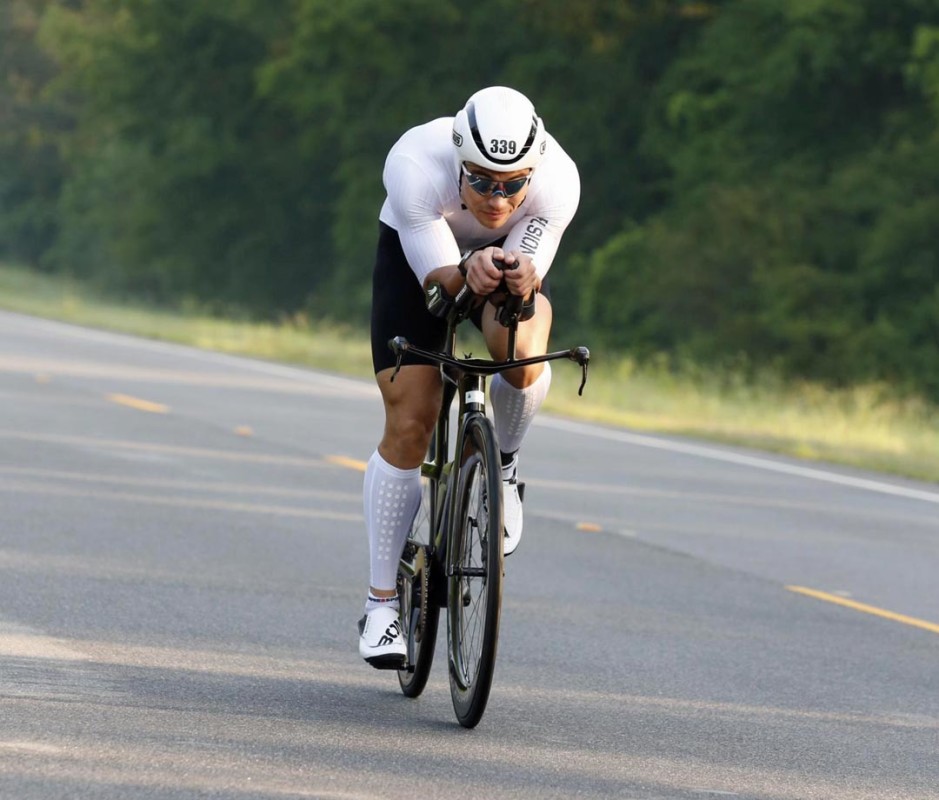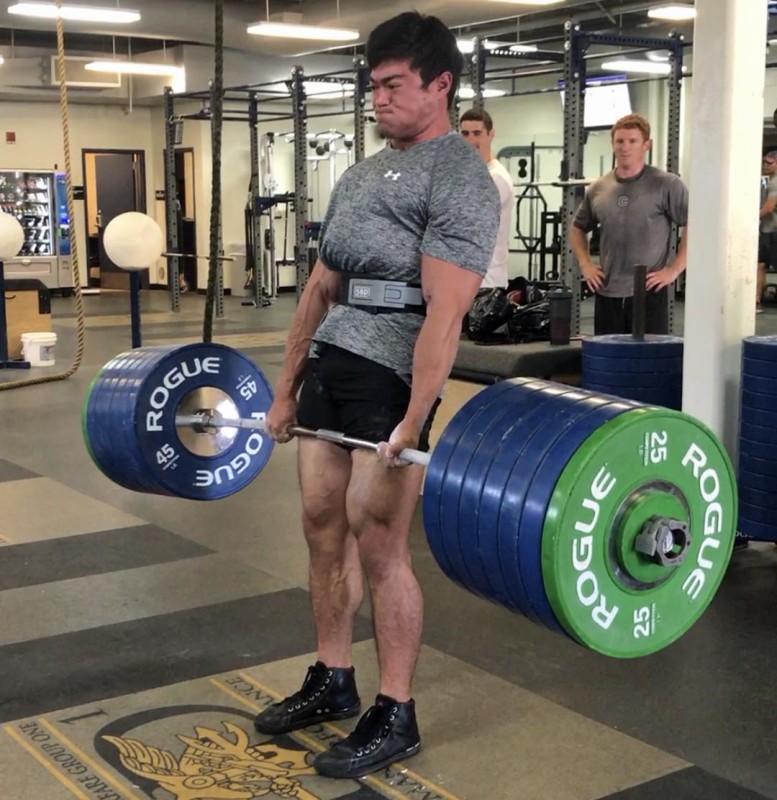[ad_1]
Being a match man has at all times meant asking whether or not you’ll be an endurance man, knocking off quick 5Ks and possibly biking centuries, or a powerful man, racking up huge numbers on the squat, deadlift, and bench.
Up to now few years, although, males have been asking, “Why not each?”
The reply has been the emergence of the hybrid athlete: Freaky robust with freaky stamina. Males like Ryan Corridor, who retired from being America’s most adorned marathon runner and now pairs lengthy runs with 500-pound yoke carries. Or Ross Edgley, the British long-distance swimmer who alternates between lake-length swims and wrangling dumbbells larger than his head. Or Scottish hybrid athlete Fergus Crawley, who squatted 500 kilos earlier than knocking off a 4:58 mile whereas weighing greater than 200 kilos.
Associated: Largest Health Tendencies of 2024 and Worst Fads to Go away Behind
Add one other identify to this checklist of superhumans: Blaine Lints. The Ph.D. candidate in kinesiology on the College of South Carolina has constructed an athletic resume that will take greater than a lifetime in simply 30 years. At 16, he ran 100 miles in 18 hours, 26 minutes and 113.25 miles in 24 hours. He turned a Navy SEAL at 18 and finally broke the SEAL deadlift report, hefting 640 kilos.
That very same yr, 2018, Lints transitioned to a brand new, hybrid coaching mode to deal with a 100-mile race whereas sustaining that deadlift energy.
“I lacked the arrogance and particular health to maintain reasonably excessive work charges for such lengthy durations,” he says. He enlisted the assistance of Alex Viada, writer of The Hybrid Athlete, and one of many pioneers of the idea. The consequence? He accomplished the 100-mile Hawaii Kai Extremely Run XTreme—as the one 100-mile finisher on the occasion—whereas sustaining the lion’s share of his energy.
In search of a brand new problem as a hybrid athlete, Lints turned to Ironman-distance triathlons in 2022. That’s a 2.4-mile swim, 112-mile bike experience, and 26.2-mile run. He largely just lately completed 4th general at Ironman Chattanooga, profitable his age group, taking 32 minutes off his time from the yr earlier than, and qualifying to go professional within the three-sport self-discipline.
Even in the event you aren’t hoping to hold 140 kilos to the highest of a mountain like Ryan Corridor, or gun for an Ironman podium like Lints, hybrid coaching gives common guys engine-building endurance to set a half marathon PR, whereas constructing shirt-filling muscle mass.
Sports activities scientists like Lints have found—and demonstrated—that lots of our previous biases towards constructing energy and stamina on the similar time don’t maintain as much as scrutiny. In a 2021 evaluation of 43 research on hybrid coaching revealed in Sports activities Drugs, scientists concluded that whereas we’ve lengthy believed that cardio train blunts our skill to get huge and robust, “concurrent cardio and energy coaching doesn’t intrude with the event of maximal energy and muscle hypertrophy in contrast with energy coaching alone.”
Associated: Jason Momoa Shares His ‘Sport-Altering’ Kettlebell Exercise to Bulk Up
Coaching energy and endurance does sound a bit like CrossFit, however CrossFit exercises, usually, tackle a number of parts of health in a single, high-intensity session. These exercises undoubtedly get you match, however they don’t tackle absolute energy (like your 1RM) and endurance in the way in which that hybrid coaching does by programming exercises devoted to every.
What Is Hybrid Coaching?
First, perceive that hybrid coaching shouldn’t be merely stacking an endurance program on high of a energy cycle. The mixed stress of two full applications provides up, resulting in harm, burnout, or each, says Lints.
Coaching correctly for 2 targets “is like placing a puzzle collectively, the place you’re making an attempt to get probably the most out of your time in a means that’s going to profit all of the belongings you wish to enhance,” he says.
For those who had been doing a traditional marathon coaching program, for instance, you may run 50 to 100 miles per week—operating nearly every single day. However operating that a lot takes up lots of time and consists of lots of mechanical stress by way of influence, Lints says, offering cardiovascular profit, but in addition beating up your legs—not nice in the event you additionally wish to do heavy squats a number of occasions every week.
“In hybrid coaching, it’s possible you’ll solely want a complete quantity of operating of 20-40 miles per week whereas substituting extra cardio coaching by means of decrease influence cardio workouts,” he says. So as a substitute of getting all of your cardio by pounding the pavement, you may spend a while on the bike, rower, elliptical, or stair climber.

Courtesy Blaine Lints
The energy coaching exercises can even be lower-volume than they might be in the event you had been solely targeted on energy. These exercises will deal with compound workouts, like squats, deadlifts, benches, and rows, and skip single-joint accent strikes like curls and leg extensions. This protects time and power.
Hybrid Coaching for Operating and Energy
Right here’s a pattern from Lints of what a hybrid program may appear like for a man who has some expertise in each endurance coaching and energy, and hopes to coach for a marathon whereas constructing energy:
MondayStrength: Heavy, lower-volume higher physique energy coaching session, targeted on a compound motion that’s a precedence.
Cardio: Interval operating, accumulating 10-40 minutes of “laborious” (round 4-out-of-5 effort) work—this might be 5 intervals of 8 minutes every, resting 2 minutes between units, or shorter intervals like 10 rounds of 200-400 meters, resting the identical quantity.
TuesdayStrength: Heavy, lower-volume leg day, emphasizing the athlete’s major compound leg motion.
Cardio: Then 20-40 minutes of low-intensity cardio—however not operating. This might be biking, the air bike, or one other cardio mode that may be performed simply.
WednesdayStrength: Relaxation.
Cardio: Threshold operating day at marathon tempo. This might embody 3-4 intervals of two miles every, 6-8 intervals of 1 mile every, or 4-5 intervals of 10 minutes every, every with 1-2 minutes relaxation between intervals.
ThursdayStrength: Larger-volume upper-body energy day.
Cardio: Relaxation.
FridayStrength: Larger-volume lower-body elevate.
Cardio: 20-40 minutes of low-intensity cardio. This might be operating, however it may be biking, the air bike, or one other cardio mode that may be performed simply.
Saturday Energy: Relaxation.
Cardio: Future. Lints says that in a hybrid program, you doubtless received’t have the fuel for a similar size of long term as in a conventional marathon program, however athletes ought to finally construct as much as 16 miles.
Sunday Complete relaxation.
Blaine Lints’s Favourite Hybrid Coaching Ideas
Give Your self Extra Time Than You Would for a Single Aim
“Issues might transfer alongside at a a lot slower charge than they might if two targets weren’t mixed,” Lints says. Guys don’t at all times take this into consideration, which may be irritating.
So in the event you’re a lifting-focused man who want to be part of associates in an extended operating race later within the yr—or a running-focused man who desires to strive a powerlifting competitors with gymnasium buddies—keep in mind that this system your one-goal associates is likely to be enterprise could also be too brief for you whilst you’re making an attempt to take care of or develop the opposite facet of your health. As a substitute of a three- or four-month buildup to a half marathon, as an illustration, you may want 5 or 6.

Courtesy Blaine Lints
The excellent news, Lints says, is that early on, your weaker facet will enhance with out including a ton of additional time—which may be critically motivating.
Observe How Your Physique’s Feeling
Including new kinds of coaching to your routine makes use of up extra power, and provides stress to each your physique and thoughts. “You even have to think about what sort of stress you’re accumulating in your every day life, whether or not that’s private stress or skilled stress.”
An excessive amount of stress can push you nearer to breaking down, or affected by overtraining syndrome, a situation that can lead to low temper, disrupted sleep, and hormonal adjustments that received’t allow you to carry out or progress.
To maintain your self from coming into this disagreeable, doubtlessly harmful state, Lints suggests monitoring how your physique responds to your coaching—however says it doesn’t must be difficult. These 4 variables are easy to trace, and solely require a pen, paper, and coronary heart charge monitor:
• Coronary heart Charge at Completely different Coaching Intensities: If you’re beginning to overdo it, your coronary heart charge could also be larger at a pace that’s often straightforward. Preserve monitor of your baseline coronary heart charge—as an illustration, your simpler cardio classes could also be at 130-140 bpm. For those who’re operating that very same tempo, however your coronary heart charge is considerably larger, again off in your coaching quantity.
• Coronary heart Charge Restoration (HRR): It is a measure of how shortly your coronary heart charge can come again to baseline after a bout of train. First, check your HRR for a baseline studying with a tough exercise. Examine your coronary heart charge instantly after your final huge effort. After which verify it once more after one minute. So in the event you completed the exercise at 180 bpm, and a minute later it’s at 120 bpm, your HRR (180-120) is 60 at base. Sooner or later, check it once more underneath the very same circumstances. Carry out the identical exercise, and relaxation in the identical place whereas timing. In case your HRR is decrease, it’s possible you’ll be overdoing it.
• Charge of Perceived Exertion (RPE): This, Lints says, is the marker he makes use of most frequently to maintain monitor of his progress and restoration wants. RPE is a score that you simply assign of how a lot effort you’re giving on a scale of 1 to 10, with 10 being flat-out sprinting. RPE is subjective, so it may possibly take time to know your effort ranges and limits. However as soon as an athlete is comfy utilizing the size, they know their physique is telling them one thing when a exercise depth that often looks like a 6 instantly looks like an 8 or 9.
• Temper: Along with monitoring your tempo, time, weight lifted, and all the opposite quantitative measures, additionally embody how exercises felt and what your temper was like. Not solely will this preserve the way you’re feeling high of thoughts, however you possibly can look again at related exercises to see in the event you felt higher or worse.
To Rebound From Overtraining, Eat, Sleep, and Dial Again Exercises
When any of those variables will get out of whack, Lints says, it’s possible you’ll be teetering on the sting of overdoing it in coaching. Begin, he says, by specializing in sleep.“Once I was in highschool, and even throughout my time within the SEALs, I usually prioritized coaching over sleep,” he says. “With my present expertise and understanding of coaching and physiology, I received’t lower my sleep to something lower than 6 hours, and I intention to get not less than 7-8 hours each night time.”
Subsequent, he says, ensure you’re consuming ample energy to take care of your physique weight. Coaching for 2 targets and coping with all the remainder of life’s challenges are already stressors. Piling a weight reduction program—or perhaps a weight reduction degree of energy—on high of that may push you in direction of breaking down.
Lastly, he says, pare down barely in your coaching till you’re feeling robust once more.
“Throughout these occasions, I draw back from performing excessive depth work, and have a discount in whole quantity,” he says. Dropping 10-20 % of your whole coaching quantity may also help you get again to your regular degree of restoration.
[ad_2]
Source link



